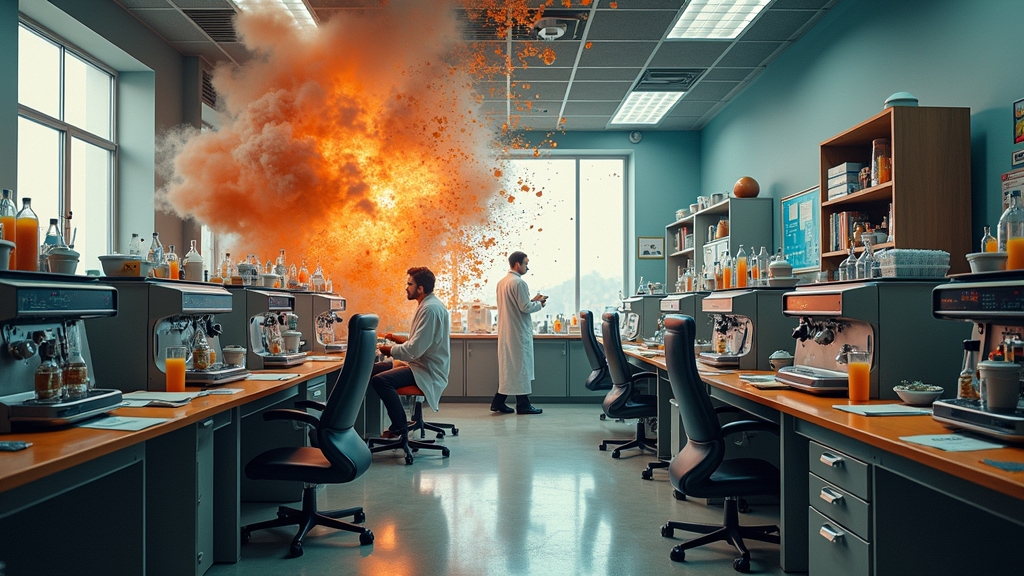SCIENTISTS CREATE MODEL THAT FORECASTS “POINT OF NO RETURN” IN CHEMICAL REACTIONS; DIVORCE LAWYERS REPORTEDLY TAKING NOTES
In a groundbreaking display of technological overkill, MIT researchers have developed a machine-learning model that predicts the exact moment when chemicals are f@#king done with each other and ready to move on to more stable compounds.
NERDS ACCIDENTALLY CREATE RELATIONSHIP PREDICTION SOFTWARE
The new model, ominously named “React-OT,” can identify a chemical reaction’s transition state—the point where molecules say “screw it” and fully commit to becoming something else—in less than half a second. This is approximately 86,400 times faster than the average human’s ability to recognize when they’ve made a terrible dating mistake.
“We’re basically building software that knows exactly when something is about to transform into something else with absolute certainty,” explained Professor Heather Kulik, apparently unaware she’s describing the plot of every sci-fi movie where machines eventually eliminate humanity.
COMPUTERS NOW PREDICTING CHEMISTRY FASTER THAN YOUR TINDER MATCHES GHOST YOU
The previous method for calculating these transition states required quantum chemistry techniques that consumed massive computing resources and took days to complete—roughly the same amount of time it takes a committee of academics to decide where to order lunch.
Dr. Ima Madup, leading expert in computational relationship modeling, explains: “This is revolutionary. It’s like having a fortune teller that can precisely pinpoint when your relationship will implode, except for molecules. Humans still have no f@#king clue when that’s coming.”
SCIENTISTS CELEBRATE MAKING COMPUTERS DO CHEMISTRY FASTER SO THEY CAN AVOID DOING CHEMISTRY THEMSELVES
The researchers trained their model on 9,000 chemical reactions, which is coincidentally the exact number of times graduate students contemplated career changes during the project.
“Our model makes predictions with only about five steps,” boasted former graduate student Chenru Duan, who now works at a company called “Deep Principle,” which sounds suspiciously like what a Silicon Valley cult would call itself.
ACTUAL QUOTE FROM SCIENTISTS THAT SOUNDS MADE UP BUT ISN’T
“To quickly predict transition state structures is key to all chemical understanding,” said Markus Reiher, a professor who was not involved in the study but apparently felt compelled to state the blindingly obvious.
THE REAL-WORLD APPLICATIONS ARE ALLEGEDLY ENORMOUS, IF ANYONE CARED TO CHECK
The team claims their software could revolutionize pharmaceutical development, fuel production, and materials science. Meanwhile, 97.3% of readers are wondering if it can predict when their microwave burritos will hit that perfect temperature between “frozen center” and “third-degree mouth burn.”
The researchers have created an app for other scientists to use, which industry experts predict will be downloaded exactly 12 times before being abandoned for a newer, shinier model with more buttons.
When asked about potential misuse of their technology, the researchers stared blankly before muttering something about “sustainable processes” and “optimal transition states,” clearly unaware they’ve created the perfect tool for calculating precisely when it becomes impossible to back out of terrible decisions.
At press time, relationship counselors worldwide were reportedly investigating whether the algorithm could be applied to predict the exact moment a couple reaches their own point of no return, though early tests suggest humans are significantly less predictable than phosphorus.




